New Year, new you. What better way to start 2022 than by reinvigorating your customer experience with chatbots? We’ve put together a list of 17 chatbot benefits to customers — perfect if you’re still on the fence.
If you run a retail or eCommerce business, it’s safe to say that you’re familiar with the herculean challenge of keeping up with the sheer volume of queries from your customers. We’re talking about questions like:
- Is this item in stock?
- Where is my order?
- Can I get a tracking number for my order?
- What are your shipping fees?
- Do you ship to (INSERT LOCATION)?
- How do I return an item?
- What is your warranty policy?
- Where can I file a complaint?
Sure, the answers to the questions are probably in a frequently asked questions (FAQ) section tucked somewhere on your website. But that doesn’t stop your customers from trying to contact you anyway.
And, as experience has probably taught you by now, the number of calls and messages surges during peak periods of shopping activity (e.g., the days leading up to Black Friday, Cyber Monday and Christmas), making it even more difficult to keep up with customer demand.
Make no mistake about it — failing to respond to customers, particularly those with complaints, will hurt your business. According to research by Khoros, 83% of customers feel more loyal to brands that respond and resolve their complaints, while 79% want to receive a fast response.
These are customer service challenges that chatbots are particularly adept at overcoming.
What Are Chatbots?
An AI chatbot is a computer program designed to simulate and process conversations with humans on digital channels, whether it be your website, mobile apps, SMS, messaging platforms (e.g., Slack and WhatsApp) or social media channels like Facebook and Instagram.
Chatbots use artificial intelligence (AI), machine learning, natural language processing (NLP) and automation to process queries and provide relevant answers — all without human intervention.

While AI chatbots are by no means new (remember Microsoft Office’s Clippy?), the technology has dramatically improved over the years, enabling bots to go beyond simple, rule-based programming.
Indeed, today’s chatbots have received a major facelift, boasting algorithms that “learn” from every conversation and understand the context of words and phrases more effectively. In addition, chatbots are no longer limited to text — voice assistants or voice bots like Siri, Alexa and Google Assistant now handle spoken language.
Related reading: Chatbot terminology guide for newcomers: 12 terms you should know
Chatbot numbers in focus
- The global chatbot market is projected to reach $102.29 billion in value by 2026, representing a compound annual growth rate (CAGR) of 34.75% from 2021 to 2026 (Mordor Intelligence).
- 69% of consumers prefer interacting with chatbots for quick communication (Salesforce).
- Chatbots are projected to save companies $8 billion per year in customer service costs (Juniper Research).
- 40% of shoppers don’t care if they’re talking to a human or AI, provided they just get answers to their questions (HubSpot).
- Organisations reduce the volume of call, chat and email inquiries by 70% after implementing virtual customer assistants, which include chatbots (Gartner).
Chatbot benefits to customers: the greatest hits
Of course, all this begs the question: are chatbots worth the time and money? If you’re on the fence about putting money into a chatbot project, you’re not alone.
Ultimately, how much value you get from a chatbot depends on your industry, your company and your customers’ needs. However, it’s also true that today’s sophisticated chatbots have a lot to offer for all types of businesses in different industries, whether it’s social housing, charities, universities or retail.
To help you make an informed decision, we’ve put together a list of 17 standout chatbot benefits for customers.
1. Instant responses to customer queries
Let’s face it, customer service in the digital world is all about speed and efficiency. According to a Forrester study, 73% of customers consider valuing their time as the most important customer service feature businesses can provide.
These findings are consistent with HubSpot’s research, which show that an overwhelming 90% of consumers rate an “immediate response” to be important or very important when they have a question concerning customer service.
What’s more, 62% and 60% of consumers in the sales and support stage of their customer journey, respectively, consider an “immediate response” to be 10 minutes or less.

How to use chatbots to provide instant responses to customers
Chatbots are the perfect solution for this challenge. When deployed correctly, chatbots can provide relevant answers to customers’ frequently asked questions (FAQs) instantly.
Customers no longer have to sit in call queues and wait several minutes just to speak to a contact centre agent. Chatbot automation ensures that customers get immediate answers to their questions anytime and anywhere.
2. Customer experience personalisation
Integrating AI-powered chatbots into your organisation’s backend systems enables the bots to perform many functions traditionally handled by customer service teams.
How to use chatbots to personalise customer experiences
Two functions stand out in particular:
- Chatbots can authenticate customers and provide them with personalised information about things like product offers, promotions, order status and payments.
- The built-in analytics backend in some chatbot platforms allows businesses to gain insight into their customers’ behaviours, purchases, preferences and needs.
Both functions enable companies to create more streamlined and personalised experiences for different customers, improving satisfaction and brand loyalty.
Case in point: H&M’s chatbot on Kik provides consumers with instant outfit inspiration. Users simply identify a piece of clothing, such as a top, and the chatbot recommends a selection of outfits, which can then be purchased on the H&M website.
Related reading: Mango: Exceptional customer experience in the changing world of retail
3. Cart recovery automation
Research by the Baymard Institute shows that customers abandon 69.82% of online shopping carts. In other words, for every 100 users that add items to their cart, around 70 leave and don’t complete their purchase.
These 70 undecided shoppers represent a critical opportunity to generate more revenue. These shoppers are already interested in your brand and product, so there’s a good chance that nudging them in the right direction will convince them to hit the checkout button.
How to use chatbots for cart recovery
This is where chatbots come in. When people think of cart recovery strategies, follow-up emails tend to be the first thing that comes to mind. They’re remarkably effective, too, winning back 3% to 14% of lost sales.
Chatbots take this feature and apply it to all your digital channels, sending cart reminders on places like Facebook Messenger and WhatsApp to lure the customer back to your site.
You’re probably wondering: That’s great for businesses, but how does this benefit customers in any way?
You can fire messages with extra benefits to compel shoppers to complete their purchases. For example, chatbots can signpost to customer benefits such as free shipping, discount coupons and cashback schemes.
4. 24/7 availability
It’s no secret that today’s customers expect businesses to be available 24 hours a day, 7 days a week. According to a report by West Unified Communications Services, 74% of UK consumers agree that it’s frustrating when customer service is only available during business/working hours.
How to use chatbots to be available 24/7
For the average business, having a customer service team available around the clock is simply too expensive to be an option. Chatbots solve this problem by using automation and AI to cater to customers around the clock. Bots don’t care about a high volume of queries either; they can process them simultaneously without being overworked or resorting to queues.
These are particularly important customer service features for businesses that operate in different time zones — think eCommerce stores that ship to the UK, US and parts of Europe, for example.
5. Omnichannel availability
Today’s customers aren’t just in a hurry (or at least feel they are); they also expect brands to be there for them everywhere. HubSpot reports that consumers want to communicate with companies through 13 different digital channels.
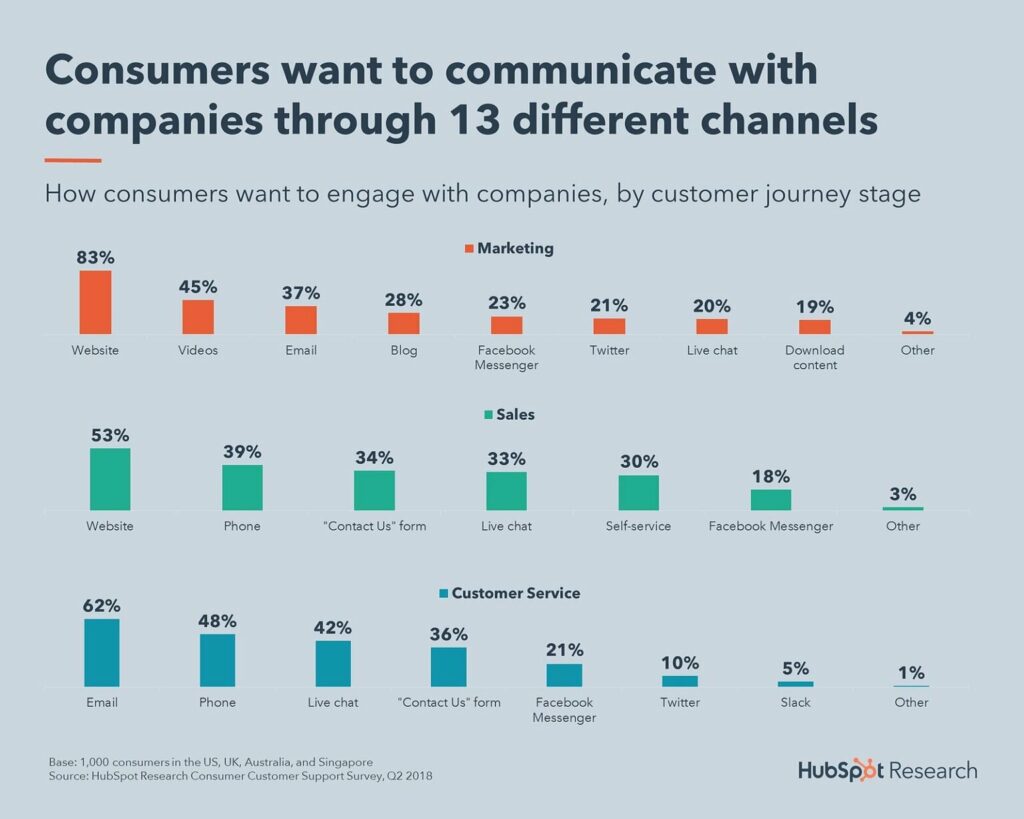
Meanwhile, research by Omnisend shows that marketers that engage customers through three more channels earned a 287% higher purchase rate in 2020 than marketers depending on a single channel. The takeaway here is simple: brands need to develop an omnichannel strategy (omni for all) to deliver customer satisfaction to customers at every stage of their journey.
How to use chatbots to create an omnichannel presence
Chatbot platforms provide a single interface that lets you deploy a front of house team of bot agents across all your digital channels, whether it’s:
- Your website
- Social media platforms like Facebook, Twitter and Instagram
- Messaging platforms like WhatsApp, Telegram and Facebook Messenger
- Your official SMS line.
This enables customers to reach you in channels where they spend most of their time.
6. Lower contact centre costs, better customer service
With companies spending over $1 trillion on customer service calls each year, chatbots represent an opportunity to lower contact centre costs and free your customer service teams from repetitive, time-consuming queries.
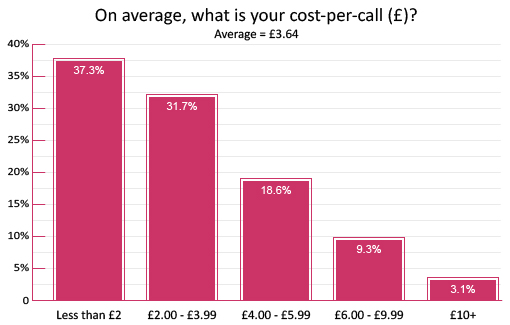
A quick bit of maths should help you get an estimate of how much money you could save by deploying a chatbot. According to a study by Call Centre, the average cost per contact across businesses sits at £3.64.
How do chatbots reduce contact centre costs?
Assuming that your chatbot answers 10,000 non-urgent questions in a year, you could be saving £36,400 in contact centre costs. And because your bots take care of repetitive and transactional messages, your customer service team can focus on more urgent and complex conversations that need a human touch, resulting in higher customer satisfaction levels.
Related reading: 3 practical applications of chatbots for customer service
7. Relevant product guidance
When potential customers land on an eCommerce website, they can sometimes feel overwhelmed by the sheer variety of product categories and products. This is particularly true for shoppers who simply want to browse your product catalogue and see what your store has to offer.
How to use chatbots to provide relevant product recommendations
Chatbots can help these customers find things they may be interested in by:
- Signposting to offers and items on clearance
- Asking questions to narrow down their search followed by a list of relevant product categories
For example, eBay’s ShopBot learns from shoppers’ browsing habits and provides recommendations like an in-store assistant.
Self-service, also known as self-serve, is a user experience feature that enables customers to complete tasks and actions without any human control or intervention.
The importance of self-service features has become even more apparent at the height of the pandemic when work-from-home setups disrupted contact centre availability. According to Salesforce’s State of Service (Fourth Edition), around four in five customer service pros reported an uptick in self-service during the pandemic, with two-thirds identifying it as critical to reducing case volume
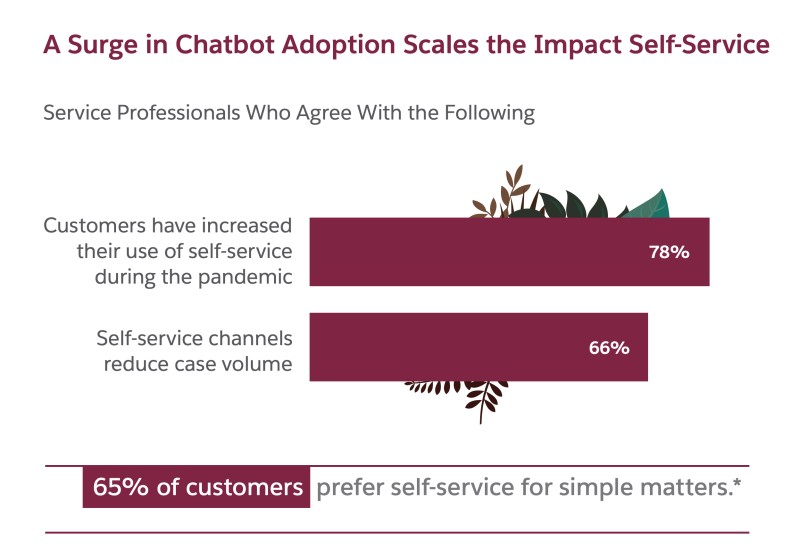
How to use chatbots to enable self-service
Chatbots can enable self-service on your site and digital channels by integrating service delivery into live chat. This allows customers to:
- Report something
- Buy something
- Check something
- Track something
- Change something.
9. Serve more customers at scale
Another benefit of providing self-service through chat is that it lets you assist more customers without requiring them to sit in a call queue just to speak to a live agent.
How to use chatbots to engage more customers
By deploying chatbots, your “lines” are available to more customers who simply need to be signposted to the right services or resources so they can resolve their questions or needs on their own.
With chatbots, you don’t need to increase your contact centre headcount to deal with the influx of calls and messages during peak shopping periods. What’s more, you can engage customers across more digital channels at scale.
10. Organic quick pulse surveys
Customer feedback is the lifeblood of any company, more so in the fast-paced world of retail. However, many businesses are still relying on old and inefficient surveying methods, such as follow-up emails and phone calls.
How to use chatbots to collect customer feedback
Chatbots can help brands capture customer feedback through automated quick pulse chat surveys. These require a lower time commitment from customers but can still generate important insights into their mood and engagement levels. More importantly, chatbots can survey customers across a wider range of digital channels, allowing you to capture more data.
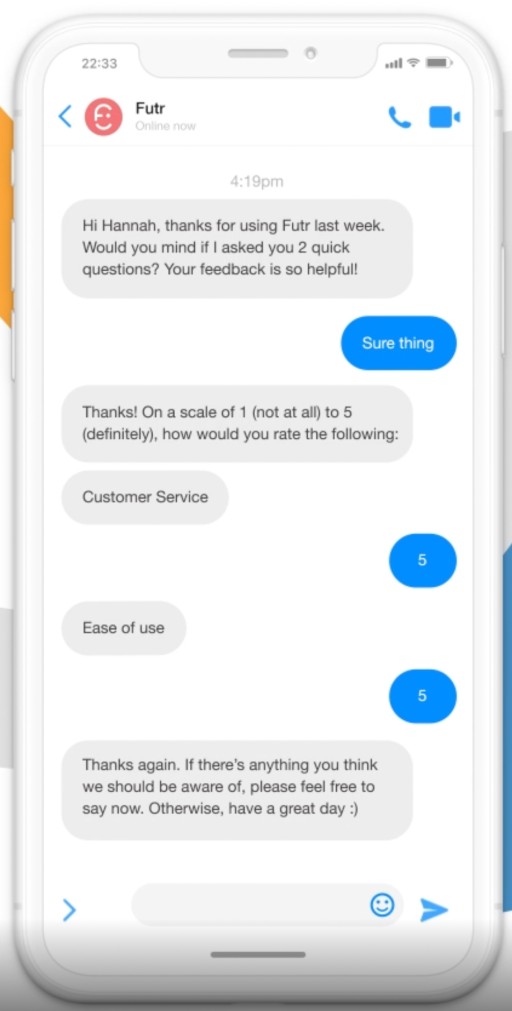
11. More channels to drive customer analytics
Customer data can provide a wealth of knowledge and insights into your customers’ shopping habits, product preferences, challenges and needs. The more data you have, the easier it becomes to develop targeted marketing messages, sales promotions and product recommendations that drive customer satisfaction.
It’s no surprise that the global data analytics market is projected to reach $684.12 Billion by 2030. To start using data analytics, you’ll need a data analytics platform like Google Analytics or a customer relationship management (CRM) tool like Salesforce. These platforms are typically linked to your site.
How to use chatbots to drive data analytics
You can also use chatbots to expand your analytics capabilities. With Futr, for example, our chatbot platform offers integrations with Salesforce, Google Analytics and Microsoft Power BI. This lets you use live chat to track metrics such as:
- Net Promoter Score (NPS)
- First contact resolution (FCR) rate
- Average ticket count
12. A more engaging alternative to paper forms
Let’s face it, customers don’t enjoy filling in paper or electronic forms manually — the process is too slow and time-consuming.
How to use chatbots as an alternative to traditional forms
With the right integrations, chatbots can deliver more engaging forms, surveys and questionnaires across all your digital channels. At Futr, our chatbot-powered conversational forms let customers provide their information without having to leave the chat. Whether your goal is to generate leads through email signups or assist with service delivery, our chatbots can transform your completion rates.
13. Multilingual chat
In a time when 80% of consumers report that they’re more likely to do business with companies that provide personalised experiences, adding expanded language support to your customer service capabilities is a great way to stand out from the competition.
Multilingual support will also enable you to engage customers from different parts of the world (great for cross-border eCommerce, for example), allowing them to ask questions or use your services in the language they’re most comfortable with.
How to use chatbots to provide multilingual support
Chatbots can help you engage customers in their preferred language by providing automatic translation queries and responses.
At Futr, our chatbots can “speak” more than 100 languages, including Afrikaans, Mandarin, French, Spanish and more. If your organisation provides critical services, such as housing, being multilingual will help you comply with language laws in places like Wales, where Welsh should be equal to English.
Explore our multilingual chat features
14. Conversational bookings and reservations
Depending on your chatbot provider’s supported integrations, chatbots can also be integrated into your online booking and reservations system. This can be a game-changer for the hospitality industry as it allows guests to book a table or room on Facebook Messenger or Telegram.
How to use chatbots for online bookings
At Futr, our slick integrations are perfect for hotels and restaurants looking to add a conversational layer of AI to their online booking infrastructure. Use chat to help customers:
- Book a callback
- Schedule appointments out of hours
- Make reservations
- Change their bookings and reservations
- Track their bookings/appointments
- Pay for something.
Discover what you can do with chatbots for online bookings
15. Seamless handover to live agents
Of course, there are some questions that chatbots can’t answer, due to their complexity or the inability of the bot to understand their full context. A chatbot can overcome this problem by providing options to escalate the conversation to a live human agent.
The ability to escalate conversations to a human agent may seem simple enough, but it’s a feature that’s less common than you might think. A 2018 report by Forrester Research predicted that the majority of chatbot deployments would be held back by “poor escalation paths to agents.”
How to escalate chatbot conversations to a live agent
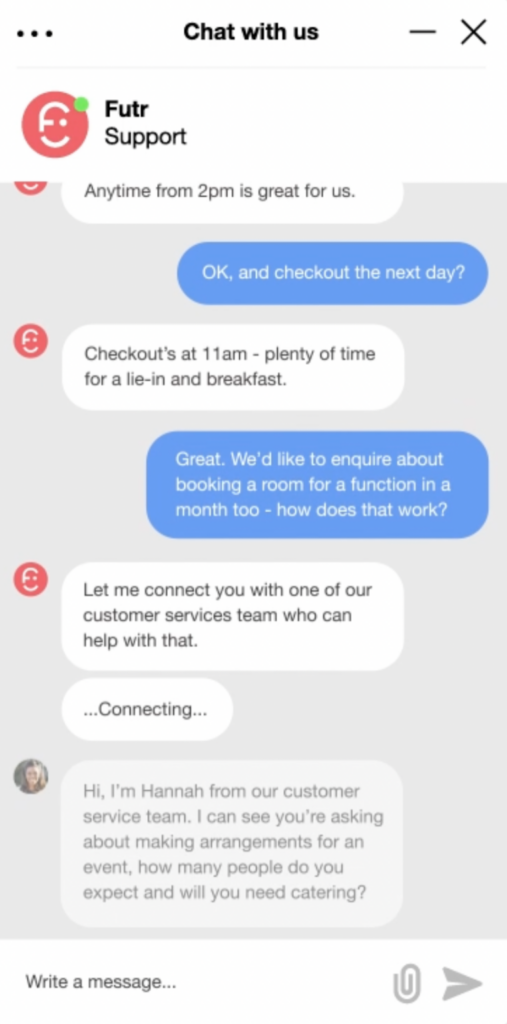
The bot can ask for the customer’s pertinent details to make the handover to a human seamless. For example, if a customer wants to report a faulty item that they ordered, the bot can ask:
- The name of the product
- When it was purchased
- A copy of the receipt (if available)
- The name and contact details of the customer
This step saves customer service teams from doing tedious and repetitive work. Outside working hours, the chatbot can generate a customer service ticket and schedule a conversation with a customer agent the next business day.
Bottom line? If you’re going to deploy a chatbot, don’t make the mistake of ignoring the feature to hand over chats to a human being.
Related reading: 5 Common chatbot mistakes that annoy customers
16. Flexible applications for all kinds of industries
While chatbots are typically associated with customer service, particularly in retail, their applications extend across a wide range of industries. At Futr, we’ve helped social housing landlords, charities and police forces use chatbots to engage their stakeholders more efficiently.
How chatbots are used in different industries
- Banking and finance: Chatbots provide an excellent way to optimise the highly transactional activities of banks and other financial institutions. For example, banking chatbots can answer customers’ questions about opening an account, reporting a lost card or where the nearest ATM or branch is.
- Charities: Chatbots can streamline fundraising activities. For example, aid groups can engage users through WhatsApp and answer questions about what they do and how people can support them. Integrations with payment processors like Strip can even enable donations within the conversation.
- Councils: Chatbots can free council authorities from dealing with the sheer volume of questions from citizens and residents about the same set of topics and issues. For example, chatbots can automatically answer questions about parking (e.g., permits, passes and the like) without involving a live agent.
- Housing: Housing chatbots help landlords and housing associations stay on top of resident queries. With chatbots able to automate up to 80% of routine customer questions, landlords can relieve support teams and provide tenants with a conversational way to schedule repairs, report incidents of antisocial behaviour and file a complaint, among others.
- Human Resources (HR): Rolling out chatbots can help HR departments and teams streamline employee recruitment, onboarding and retention. For example, candidates can interact with a bot to guide themselves through the hiring process and submit CVs, cover letters and schedule interview dates — all within the chat.
- Insurance: Insurance chatbots can speed up insurance applications and claims by enabling self-service on your digital channels. This allows customers to use chat and submit claims, change their policy, purchase add-ons, add members to their policy, and more.
- Police: Police forces struggling to manage demand for policing can use chatbots to stay on top of non-urgent calls, many of which go unanswered. For example, in 2019, the BBC reported that 49% of calls to the Met Police’s Crime Management Service (CMS) were answered.
- Universities: Chatbots can help universities stay on top of the thousands of questions students and parents have about everything from enrollment and Clearing to graduate programmes and alumni services.
17. Customers only need to provide their information once
If you’ve made customer service calls in the past, you’ve probably experienced being asked to provide the same set of information to two or more agents in different departments. This information may include:
- Your name
- Your contact information
- Your address
- A reference number.
This process only happens once with chatbots.
How chatbots collect and use customer information
A chatbot only asks for a customer’s information once and remembers it until they find a resolution to their question or problem. If the message is urgent or too complex for the bot and has to be escalated to a human, that same information will be passed on to a live agent. This eliminates the need for the customer to repeat themselves.
Once the conversation ends, users can ask their information to be deleted — a request organisations in the EU and UK have to comply with to meet GDPR requirements.
Reap the customer benefits of chatbots today
Follow the Futr blog for more insights on how our chatbots can help you transform the customer experience on your site and digital channels. Get in touch with the Futr team to learn how live chat and chatbots can streamline and supercharge your customer service capabilities.

